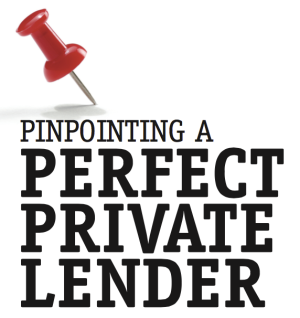How to Pick a Private Lender

The borrower can use a checklist when evaluating a private lender to see if they’re a proper match for the client’s unique needs. This evaluation can be broken into three sections:
1) Creative structuring,
2) customizing the mortgage to fit the unique needs of the client,
3) appropriate exit strategy.
1) Creative Structuring
- The client’s loan amount is the constant in this equation. Ideally the formula should reflect the client’s cash flow. The two options are:
- buying down the rate (lower monthly interest rate with higher fees), or
- buying up the rate (higher monthly interest rate with lower fees).
- Whether buying up or down it’s the same amount of money to the client. A payment structure determined by the client’s cash flow helps them afford their solution.
2) Customizing the Mortgage
- Customizing the length, or term, of the mortgage can save the client from repayment penalties. Typically, there are penalties for fully repaying a contract before it expires. Galli suggests that brokers urge private lenders for a term which matches the client’s specific needs.
- The next thing to consider is if the private lender accepts multiple collaterals. Traditional financial institutions will turn away from this option but many private lenders will use it as a tool to secure the deal. When a private lender accepts multiple collaterals, at least one additional property is added to the equation. This might be another property of the client’s, such as a summer home or condominium, or it may be the home of a family member. The client now has more to lose but sometimes it’s their only way to secure a new mortgage. “We call this an emotional collateral,” Galli explains, “There’s the real collateral (the physical properties) but emotionally, are you going to want to let family members sink and lose their homes too? At the end of the day they often don’t.”
3) The Exit Strategy
- Not only should there be a way out, but an opportunity to rebuild credit.
- A favorable option offered by some alternative lenders is a secured credit card in which the deposit is included in the mortgage. Some private lenders will also work with clients to pay off and leave their existing lines of credit open. By helping the client to rebuild and maintain active credit, it enables them a better chance to eventually move towards a more traditional source of financing.
Interviewing the Lender
1) Does the private lender have a credible source of funds?
- All transactions must be done through the banking system (i.e. certified cheques, wire transfers).
- The money should be traceable; cash, for example, is not a credible source of funds.
2) Does the private lender have the ability to fund?
- The lender might have a credible source of funds but that doesn’t mean it necessarily has the volume to fund the mortgage. “Sometimes the private lender has bigger eyes than their stomach--when it gets to funding they don’t have the cash,” Galli says, “It’s kind of like not showing up at the altar. This is bad because the borrower is in default and en route to losing their home.” Galli advises that the broker consult his or her network. Chances are a lender with this problem will have had issues funding in the past.
3) Does the private lender fully disclose terms and conditions, fees and penalties?
- A lack of transparency is a telltale sign that the lender’s leaning towards the repossession side of the spectrum.
- The first question to ask is, what’s your collection policy on lates and arrears? A soft approach would be calling the client to work through the problem. A hard approach varies from penalties, and or, an automatic increase to the interest rate; to immediately send a collector, and or, taking legal action in reclaiming the property. Along with this, the broker should ask what will happen to his or her client if they do not repay the loan. Lenders focused on repayment will work with the client and possibly offer an extension on the term, often between one to three months in length. It is important that while the broker evaluates the lender, he or she have a clear understanding of how quickly the private lender will take legal action on a property. Finally the private lender should provide the broker with a breakdown of their pricing structure. This will include all possible fees and penalties. This is where the broker must pay attention.
- Does the private lender charge to issue a mortgage review, approval, and or term sheet? Some- times there are undisclosed, non-refundable, fees that the client pays before a new mortgage is even approved.
- Are there exit fees? This can range from a fee to close the account, through to statement and penalty fees. If the client were to default, the broker should know what the penalties will be and how this will affect the interest rate. If the lender offers renewals they should also disclose how this affects the rate. Now the crucial information to bring back to the client is whether or not they would have the cash flow to support these new payments?
“Some lenders charge statement fees and penalties at the end--even if the client has respected the contract,” says Galli. “Some lenders charge X amount or a percentage of the contract. Even if the clients respected the terms and conditions and are ready to pay off their mortgage, there may be hidden fees. This is a disclosure issue.” - This information should be laid out for the client upfront in the mortgage approval before being sent to a notary or lawyer.
- Transparency from a lender is an integral sign that the broker is leading his or her client towards a potential solution.
4) Does the private lender build an exit strategy?
- An exit strategy is indicative of lenders who aim for repayment when a file closes. The goal is to help the client take charge of their finances and eventually transition to a more traditional financial institution.
5) What is the private lender’s speed of execution?
- There are two components to this question: the lender’s speed in underwriting a deal, and how quickly they can fund. A mortgage approval can be same-day, next-day, or it can take days through weeks. The ability to fund ties into the lender’s funding credibility and volume, as some lenders have to wait weeks before providing the loan.

